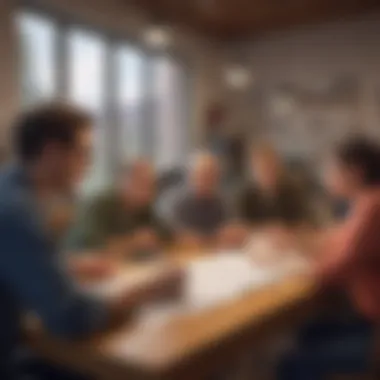The Creative Journey: Insights from Pixar


Intro
Pixar Animation Studios has carved a niche not just in the realm of animated films but also in our understanding of creativity. From the vibrant emotional arcs in Toy Story to the nuanced narrative of Inside Out, the essence of creativity at Pixar serves as a beacon for industries far beyond animation. What makes Pixar stand out is its unique blend of collaboration, leadership, and a culture that nurtures innovative ideas.
As we dive deeper into this exploration, it’s crucial to recognize how Pixar's methods can inform our own creative endeavors. The studio’s environment encourages risk-taking and fosters collaboration, making it a model worth dissecting. This article aims to illuminate the key components that contribute to the creative dynamism inherent at Pixar, examining how their framework has evolved over the years and the implications this holds for the broader cultural landscape.
The following sections will detail the mechanics of creativity at Pixar, drawing connections between theory and practice while offering insight on how to cultivate similar environments in various organizational settings. As we peel back the layers of Pixar’s creativity, readers will find valuable ideas to apply in their personal and professional growth journeys.
Prolusion to Pixar's Creative Landscape
When one thinks of animated films that capture both the heart and the intellect, Pixar emerges as a towering figure in the industry. This introduction sets the stage to navigate through Pixar's innovative landscape, reflecting on how creativity is not merely a byproduct of artistic talent but a well-orchestrated symphony involving various elements. Each aspect of Pixar's process—collaboration, design, and leadership—offers insights into why it excels in captivating stories that resonate with audiences of all ages.
In this exploration, it becomes evident that the magic lies in the intricacies of its creative ecosystem. The thoughtful interplay between animators, storytellers, and technology creates a fertile ground where ideas flourish. By focusing on the dynamics of this environment, readers can appreciate the multi-dimensionality of creativity that defines Pixar’s legacy.
Overview of Pixar's Legacy
Pixar Animation Studios isn't just a name in animated film; it's a landmark in storytelling techniques and artistic innovation. Established in the late 1970s as part of Lucasfilm, it evolved through its adoption of groundbreaking computer animation technology. When "Toy Story" debuted in 1995, it shattered expectations, marking the beginning of a new era in cinema.
What sets Pixar apart is its consistent ability to deliver emotionally charged narratives wrapped in humor and relatable characters. The films produced by Pixar have not just entertained; they've imprinted cultural significance. Films like "Finding Nemo" and "Inside Out" go beyond mere animation to tackle themes of loss, growth, and self-identity.
From the colorful depth of the worlds created to the nuanced portrayal of complex emotions, Pixar's legacy teaches valuable lessons about human experiences. The studio's commitment to quality and experimentation resonates widely, keeping its films perennially relevant in a fast-paced digital era.
The Role of Animation in Storytelling
Animation is often seen as a form of entertainment primarily for children. However, Pixar flips this notion on its head and illustrates that it is a profound storytelling medium capable of conveying layered narratives. The beauty of animation lies in its versatility; it allows for the creation of worlds unbounded by physical reality.
The studio utilizes animation not just as a tool for visual representation, but as an instrument to narrate complex human emotions and relationships. Consider the film "Up," where the vibrant animation couples with an emotionally gripping backstory—it’s the perfect example of how non-realistic shapes and motions can convey profound truth about life, loss, and adventure.
Moreover, Pixar blurs the line between realism and fantasy. Characters, despite their anthropomorphic nature, embody traits and struggles familiar to audiences, creating situations that evoke genuine empathy and laughter. In effect, animation becomes a universal language, capable of breaking down barriers and transcending cultural differences.
"Animation ignites imagination. It lets us dream together, and inspires creativity."
In analyzing Pixar's approach, one can observe how animation paves the way for storytelling mastery. The studio’s commitment to pushing boundaries in animation not only engages its audiences but also reflects society’s shifting narratives.
Overall, Pixar is more than just a name; it is an institution that continues to explore the essence of creativity through the lens of animated storytelling.
The Foundations of Creativity
Creativity serves as the bedrock of Pixar’s legacy, shaping not just its films but also its entire organizational culture. Understanding the foundations of creativity within Pixar helps to reveal how the studio consistently crafts stories that resonate with audiences across ages. This section dives into the very essence of creativity—what it is and how it manifests in the rigorous workflow of a renowned animation studio.
Defining Creativity
Creativity can often be seen as an elusive concept, something that people think is either innate or unattainable. At Pixar, creativity is defined not just as a spark of inspiration or artistic flair, but as a multifaceted and collaborative process. It relies on the notion that everyone, regardless of their role, possesses the potential to contribute creatively.
- Innovation is not limited: Creativity at Pixar isn’t exclusive to writers or artists. Engineers, animators, and even administrative staff have the opportunities to voice creative ideas. This blending of perspectives enriches the storytelling process.
- A shared vision: The studio places immense importance on collective creative problem-solving, building an environment where ideas can iterate and evolve before they hit the screen.
In essence, creativity at Pixar is about breaking down silos, ensuring that every voice can enrich the narrative tapestry. Here, creativity is as much about collaboration as it is about individual talent.
The Creative Process: Stages and Approaches
Every Pixar production is a dance through stages, akin to a well-rehearsed choreography where each member plays a critical part. Understanding this creative process can shed light on how Pixar navigates from initial concepts to a finished film.
- Ideation Phase: It all starts with brainstorming sessions that can sometimes last several hours. The goal here is to flood the room with raw, unfiltered ideas. No suggestion is too wild; the key is to encourage free-thinking. This phase fosters brainstorming and sets the tone for what’s possible.
- Development and Storyboarding: Once an idea is fleshed out, storyboards come into play. Artists sketch key scenes, crafting a visual narrative that helps pinpoint how the story will unfold.
- Prototyping and Testing: Creating rough animations allows teams to test how ideas flow. This iterative phase can seem tedious but brings clarity to the project’s trajectory. Feedback from both creatives and outside viewers helps inform necessary alterations early on.
- Final Production: With a solid foundation laid, the production team dives into creating the final animation, leveraging cutting-edge technology and techniques to bring the characters to life.
- Post-Production: Editing, sound design, and tests are conducted, aiming to finalize the masterpiece.
In every stage, flexibility is crucial. Ideas can shift dramatically, and so are the approaches to storytelling. The Pixar team acknowledges that creativity can come from anywhere, at any time, reinforcing the belief that preserving a fluid and adaptive creative process breeds exceptional results.
"Creative ideas often come about not from moments of solitude, but from the collaborative efforts of a diverse team."
Overall, the foundations of creativity at Pixar are built on mutual respect and an understanding of the power that diverse voices contribute to the arts. This becomes the essence that drives innovation at the global stage.
Collaboration as a Catalyst
Collaboration at Pixar acts as the oil that keeps the engine running smoothly, facilitating the creative processes that bring animated stories to life. It’s not merely about people working together; it’s about intertwining diverse ideas, skills, and perspectives that fuel innovation. Pixar's unique ability to blend different talents creates a rich tapestry of creativity that can’t easily be replicated.
When a group of artists, writers, and tech-savvy individuals come together, the result can be transformative. Collaboration fosters an environment where brainstorming can flourish. Imagine a roundtable discussion with animators sharing sketches, writers suggesting dialogue, and musicians playing melodies that set the mood. This dynamic exchange leads to a cross-pollination of ideas that enhances the storytelling aspect of their films, making them richer and more engaging.
In addition, collaboration reduces the chances of creative stagnation. A single artist might find themselves in a creative rut, but when surrounded by a team, fresh perspectives can spark innovation. Here’s a thought: it's like making a pot of stew. Each ingredient contributes its flavor, and together they create a delectable dish.
Benefits of Collaboration


- Broader Perspectives: Team members come from various backgrounds, each offering unique insights. This diversity can uncover hidden aspects of a story.
- Enhanced Problem-Solving: Different viewpoints help solve complex issues that may arise during production.
- Increased Accountability: When working together, team members hold each other accountable, pushing everyone to maintain high standards.
Considerations for Effective Collaboration
- Open Communication: It’s crucial for teams to communicate clearly and frequently. Otherwise, misunderstandings can complicate the creative process.
- Trust and Respect: Each member should feel valued for their contributions, establishing a foundation of trust.
- Flexibility: Adaptability is key. Sometimes ideas need to shift unexpectedly, and teams must be prepared to pivot.
When you combine these elements, you foster a culture where creativity isn't just a possibility; it’s a given. That’s part of the reason why Pixar is so successful at telling stories that resonate globally.
"Collaboration isn't just about working together; it's about elevating each other’s ideas to create something greater than the sum of its parts."
Team Dynamics at Pixar
The team dynamics at Pixar are meticulously crafted to encourage collaboration. The layout of their studios plays a pivotal role, designed to promote interaction. Open spaces, combined with cozy nooks, allow team members to come together or retreat when they need space. The layout isn't just about aesthetics; it's about function. It encourages spontaneous conversations during coffee breaks or meetings in casual settings, where great ideas often bubble to the surface.
Moreover, Pixar employs a strategy of seating arrangements that mixes employees from different departments. This way, a director might share lunch with an animator or a sound designer, creating connections that might not form in a more traditional office setting. These relationships can influence goals and align everyone with a shared vision. By emphasizing teamwork, Pixar ensures that creativity flows freely rather than becoming mired in corporate bureaucracy.
Cross-disciplinary Influences
Pixar thrives on influences from a vast array of disciplines. The intersection of various arts and sciences is like throwing a handful of colors onto a canvas — the unexpected combinations create stunning visuals. For instance, collaborations between animators and psychologists lead to deeper character development, ensuring that audiences connect emotionally with the stories. Though they all come from different backgrounds, like paint and canvas, each element complements the others.
Furthermore, the incorporation of technology and science into the creative process showcases how progressive Pixar is. Animators often collaborate with engineers to push the boundaries of what is technically possible in animation. This synergy between artistry and engineering enables Pixar to present visually striking films that push the envelope, creating immersive experiences for viewers.
In summary, collaboration at Pixar is not just encouraged; it’s woven into the very fabric of their creative process. Team dynamics and cross-disciplinary influences work in tandem to cultivate a thriving atmosphere where innovation can take root and grow. This commitment to collaboration ensures that Pixar continues to lead the charge in animation, consistently delivering stories that leave a lasting impact on their audience.
The Importance of the Work Environment
Creating a productive and innovative work environment is crucial for fostering creativity. At Pixar, this isn’t just a motto; it’s a core principle. The space where people create matters a whole lot. It influences how ideas flow and how teams gel together. From colorful studios filled with doodles to open spaces encouraging spontaneous interactions, Pixar’s physical setup is designed to break down barriers and spark new ideas. But there’s more to it than just flashy designs. The structure of a workspace affects not only creativity but also employee satisfaction and productivity. A thoughtful environment can cultivate a sense of belonging, which is essential for collaboration.
Physical Space and Design
Pixar’s physical environment is a masterpiece in itself. The design philosophy revolves around openness and interactivity. The atrium, buzzing with life, serves not merely as a walkway; it’s a meeting point where the unexpected can happen. People bump into each other, ideas flow freely, and collaborations sprout spontaneously. The layout encourages interactions that might not otherwise occur in a more traditional office structure. There are dedicated spaces for brainstorming that are filled with comfy couches and whiteboards, allowing for all kinds of thoughts to be jotted down and explored.
Moreover, the whimsical art and colorful murals splashed around the studios serve as constant inspiration, reminding everyone of the creativity that lies at their fingertips. Such design elements can significantly uplift spirits and nurture a vibrant atmosphere. Spaces devoid of a rigid structure allow creativity to flourish, demonstrating that a cluttered, engaging environment often breeds innovative designs and captivating stories.
"A pleasant work atmosphere can convert mundane tasks into enjoyable endeavors, paving the way for something extraordinary."
Psychological Safety for Innovation
Creativity thrives in an environment where individuals feel safe to express ideas, however unconventional they may seem. At Pixar, psychological safety is paramount. Employees are encouraged to voice their thoughts and opinions without fear of ridicule or retribution. This openness not only empowers individuals but also encourages risk-taking and experimentation, fundamental elements of the creative process.
This trust and support foster a culture of sharing, acceptance, and constructive feedback. When a studio member presents a new idea, they do so knowing that team members will contribute positively rather than criticize harshly. This kind of environment ensures that the bar is continually raised in terms of aspirations and creative possibilities.
Ensuring a psychologically safe space means that teams are much more likely to push boundaries and explore narratives that resonate deeply with audiences. It’s about building confidence in every member of the team, creating an atmosphere where innovation isn’t just encouraged—it’s expected. This is how Pixar consistently brings to life stories that tug on heartstrings while keeping audiences guessing at every turn.
The work environment at Pixar exemplifies that the right mix of physical space and psychological safety can create a breeding ground for immense creativity, ultimately leading to stories that echo the complexity and beauty of human experience.
Leadership and Creative Freedom
The relationship between leadership and creativity is a crucial one at Pixar. Leadership sets the tone for innovation, shaping the creative landscape in which stories come alive. In many ways, effective leadership cultivates a nurturing environment where creativity flourishes. Creative freedom emerges as a pivotal element, allowing individual talents to thrive while contributing to the collective vision of the studio. When leaders prioritize autonomy, they empower creatives to take risks, think outside the box, and ultimately create groundbreaking narratives that resonate across cultures.
Steve Jobs and Leadership Philosophy
When discussing leadership at Pixar, the influence of Steve Jobs cannot be overstated. Jobs championed a culture that embraced both creativity and collaboration. He believed in the power of storytelling and the transformative potential it holds. His insistence on maintaining a flat organizational structure dismantled bureaucratic barriers, enabling teams to communicate more freely. This philosophy allowed artists and technologists to interweave their ideas, sparking innovation.
- Key Aspects of Jobs’ Leadership Style:
- Visionary Outlook: Jobs had a unique ability to foresee trends, which often led the team towards uncharted territories in animation.
- Passionate Involvement: He engaged directly with projects, inspiring others through his passion.
- Emphasis on Quality: His discerning eye maintained high standards, pushing teams to deliver their best work.
"Innovation distinguishes between a leader and a follower." – Steve Jobs
Jobs’ philosophy was about more than just managing; it was about instilling a sense of purpose and enthusiasm within teams. He knew that giving creatives the freedom to explore their ideas could lead to astonishing results.
Empowering Creatives at Every Level
Empowering creatives isn't just a lofty ideal; it’s a practical strategy employed at Pixar. By encouraging autonomous decision-making, leaders foster an atmosphere where team members feel valued and inspired. It’s crucial to recognize that every voice counts, whether in the animation department, storyboarding, or technical support. This inclusivity not only enriches the creative process but also ensures a diverse range of ideas contribute to the final product.
- Benefits of Empowerment:
- Enhanced Creative Output: Individuals allowed to express themselves are likely to produce more imaginative and unique work.
- Increased Job Satisfaction: Creatives who feel trusted and valued are more engaged and likely to remain with the company.
- Collective Problem Solving: A collaborative spirit leads to innovative solutions that may not have surfaced in a more hierarchical setting.


Pixar's leadership style, rooted in freedom and empowerment, goes a long way toward fostering a culture where creativity can thrive. This approach doesn't just apply to animation; other industries can learn valuable lessons from Pixar's model. By focusing on trust, respect, and the freedom to explore, businesses can open the door to a wealth of creative possibilities.
Storytelling as an Art Form
Storytelling holds a significant role in Pixar’s creative landscape. It serves not just as a framework for crafting narratives but as a vital component that breathes life into characters and plots. The power of storytelling at Pixar isn’t merely in entertaining audiences; it taps into the shared human experience, connecting people across different backgrounds and cultures. When a film resonates emotionally, it forms an invisible thread linking the viewer's perspective with the creators’ vision.
The Elements of a Captivating Narrative
A captivating narrative is not merely about the progression of events; it embodies a blend of elements that fuse together to create an engaging tale. Notably, a solid foundation lies in well-defined characters. These are not just figures populating the screen; they are intricately developed individuals that viewers can relate to or aspire toward. Each character's journey is rich with struggles and victories, rendering them relatable.
Another essential element is conflict, which propels the story forward. In Pixar's films, conflicts vary widely—from internal struggles within characters to external challenges posed by antagonists. This dynamic creates suspense and keeps audiences invested, eagerly turning every page of the animated story.
Moreover, setting plays an equally critical role. The landscape, be it the whimsical world of "Toy Story" or the vibrant undersea realm of "Finding Nemo," not only provides context but also influences characters' actions and growth. A well-crafted setting deepens the audience's immersion into the narrative.
One cannot overlook the importance of pacing. The rhythm of the story affects how viewers digest its narrative. A snappy pace might be suitable for a comedic moment, while a slower build might enhance emotional revelations. When these elements dance together harmoniously, they create a narrative that captivates the audience and lingers in their hearts long after the credits roll.
Balancing Humor and Emotion
At Pixar, the balance between humor and emotion is artfully executed, often leading to impactful storytelling. The films often explore serious themes, yet they are interlaced with humour, allowing the audience to process deeper messages without feeling overwhelmed.
Comedy acts as a gateway, engaging viewers and making them receptive to more profound, sometimes painful truths. Films like "Inside Out" exemplify this, juxtaposing the humor found in childhood misadventures with the complexity of navigating emotions. The laughs lighten the load, making way for heartfelt moments that resonate on a deeper level.
It takes a skilled team to gauge when to insert levity and when to showcase gravity. The comedic timing must align seamlessly with emotional beats, so neither overshadows the other. For instance, a character’s comedic misstep can serve to illuminate a more serious realization without detracting from the overall message.
Ultimately, the ability to balance humor and emotion creates a rich tapestry that speaks to viewers, allowing them to find laughter in despair and solace in joy.
In sum, storytelling as an art form at Pixar surpasses mere entertainment. It intertwines key elements like character development, conflict, setting, and pacing with a delicate balance of humor and emotion, crafting narratives that resonate profoundly and universally.
Technological Innovations and Creativity
Pixar has always been at the forefront of blending cutting-edge technology with the imaginative world of animation. The role of technological innovations cannot be overstated. They serve as the engine that drives creativity, enabling art to evolve and express unique stories in ways previously unimagined. By investing in research and development, Pixar pushes the boundaries of what’s possible, ultimately enhancing viewer experiences.
Advancements in Animation Technology
Throughout the decades, Pixar has made waves in the animation world by not just using technology, but by innovating it. From the early days of ‘Toy Story,’ Pixar introduced groundbreaking rendering techniques. These advancements allowed for more realistic textures, lighting, and movement. The shift from traditional 2D animation to 3D rendering opened up a new realm for story creation.
Some key technologies that have shaped Pixar's filmmaking includes:
- RenderMan: This proprietary software has revolutionized the way light interacts with objects in film. It allows for stunning visual effects that are almost lifelike.
- Previs: Short for pre-visualization, this technique lets creators map out scenes in a 3D space before the final animation process. It streamlines production and cuts down costs.
- Fur and Cloth Simulation: In films like ‘Monsters, Inc.’ and ‘The Incredibles,’ realistic animating of fur and fabric was made possible through advanced simulations, making characters resonate more with audiences.
Thus, advancements in animation technology not only enhance storytelling but also evolve the artistic expressions that can be achieved in animated films.
Integrating Technology with Artistic Vision
At Pixar, technology and artistry go hand-in-hand, creating a harmonious balance. While the studio embraces digital tools and techniques, the heart of each project remains rooted in storytelling and the art form. Every technological innovation is viewed through the lens of its potential to serve the narrative.
For instance, consider how "Finding Nemo" utilized underwater simulations and light modeling to create a visually captivating experience. This level of realism drew viewers deeper into the oceanic world, promoting emotional connections with characters.
It's not just about having the latest gadgets. Every piece of technology is thoroughly understood and employed to amplify the artistic vision. This interplay can be summarized in several points:
- Collaboration: Artists and technologists work closely, ensuring that each scene is not just technically sound, but visually evocative.
- Experimentation: The culture at Pixar encourages trial and error, allowing teams to discover unexpected ways technology can enhance storytelling.
- Feedback Systems: Regular reviews foster a space where creative ideas can be shared and revised based on technological capabilities.
"Technology is not a replacement for creativity but a tool to expand it."
This approach has led to artwork that resonates on multiple levels – appealing to both the heart and mind. By intertwining technological advancements with artistic creativity, Pixar continues to set the bar high in animated storytelling.
Cultural Impact of Pixar's Films
Pixar Animation Studios isn’t just a powerhouse of creativity; it has fundamentally changed the cultural landscape of animated films and storytelling. Its influence stretches beyond the screen and seeps into everyday conversations, impacting themes of family, friendship, and personal growth. In the realm of animation, Pixar is often seen as a beacon of innovation, not just in technique but in the narratives it chooses to explore. The importance of discussing Pixar's cultural impact lies in how it redefines our understanding of animated movies as vehicles for deeper life lessons.
Pixar's Influence on Global Cinema
From the initial success of Toy Story in 1995, a film that did more than deliver laughs and clever plot twists, Pixar set the stage for a new era in animated storytelling. The studio's commitment to crafting captivating narratives with emotional resonance has fundamentally shifted audience expectations worldwide. The artistry in each frame does not just entertain; it elevates animated films to a status on par with live-action cinema.
The rich, character-driven stories become a part of popular culture. For example, films like Finding Nemo and Inside Out address complex emotional themes that resonate deeply, providing viewers of all ages a space for reflection. People find themselves quoting characters or recalling scenes, which often lead to profound discussions about identity, loss, and resilience.
Moreover, Pixar has pioneered the integration of technology and storytelling, often setting industry standards. Its ability to utilize cutting-edge animation techniques while maintaining strong narratives has inspired countless studios globally. In many ways, Pixar’s influence has democratized animation.
- Spreading Universal Messages: The themes explored in Pixar films often transcend cultural and linguistic barriers, allowing for global accessibility.
- Innovative Storytelling Techniques: The implementation of narrative arcs that evolve characters deeply influences storytelling methods beyond animation.
- Cultural Conversations: Titles like Coco encourage dialogues about cultural heritage and family, bridging gaps and fostering understanding among diverse audiences.


Exploring Themes of Identity and Connection
One of the core strengths of Pixar's narratives is their ability to weave themes of identity and connection throughout their films. Characters in Pixar movies are often portrayed on journeys of self-discovery. From Ratatouille, where a rat named Remy pursues his passion for cooking in a society that ostracizes him, to Soul, which delves into the existential questions about purpose and passion, these films stimulate thought about who we are and where we belong.
"To create is to live twice."
Furthermore, the connection between characters often reflects our own relationships in real life. The poignant interactions between Andy and Woody in Toy Story explore the bond of friendship, shedding light on the bittersweet nature of growing up. In another angle, The Incredibles highlights familial bonds, illustrating that everyone has their own struggles and strengths.
These themes resonate strongly with audiences:
- Relatability: Viewers often see their struggles mirrored in characters, fostering a deep emotional connection.
- Cultural Identity: Films like Coco go beyond individual experiences, embracing cultural roots, which helps audiences explore their identities.
- The Power of Collaboration: Many of Pixar’s movies celebrate teamwork, reflecting the studio's own collaborative spirit, further emphasizing the importance of connection.
In summary, the cultural impact of Pixar extends far beyond entertainment. The studio ignites conversations about identity, emotion, and the significance of relationships—celebrating the human experience in a way that resonates on a global scale. This ability to invoke thought and emotion cements Pixar's role not just as an animation studio but a cultural touchstone in cinematic history.
Lessons on Creativity in Business
Creativity isn’t just a fanciful notion; it’s a cornerstone for success in today’s business world. The ability to innovate, adapt, and think outside the box is what sets leading companies apart. By delving into the lessons derived from Pixar's practices, businesses can glean invaluable insights that foster a culture of creativity. These lessons range from fostering collaboration to embracing failure as part of the process. In an age where stagnation can lead to irrelevance, understanding these principles becomes a strategic imperative.
Applying Pixar's Principles to Various Industries
Pixar didn’t reach the pinnacle of animation solely due to their artistic talent; they honed a specific set of principles that can be applied across different sectors. From tech start-ups to large manufacturing firms, understanding these core elements can drive meaningful change.
- Emphasizing Collaboration: At Pixar, ideas are born from a collective effort rather than individual brilliance. Businesses should encourage open dialogue within teams, promoting an environment where everyone feels free to share thoughts.
- Fostering Playfulness: Creativity thrives in playful environments. Companies should strive to eliminate fear of criticism and push for experimentation, thereby allowing employees to explore new avenues without the weight of failure.
- Iterative Improvement: Pixar often revisits and reworks their projects multiple times, learning from each iteration. This continuous improvement mindset is vital; businesses can adopt mechanisms that promote feedback loops and regular revisions of ideas.
Fostering Innovation Within Organizations
Creating a culture of innovation doesn’t happen overnight; it necessitates commitment and the right environment. Working with Pixar's framework, organizations can take proactive steps to nurture creativity.
- Psychological Safety: Employees need to feel safe enough to voice unconventional ideas without the fear of rejection. This cultural foundation serves as the bedrock for innovation. Pixar’s practices show that a fearless culture breeds productive brainstorming.
- Diverse Perspectives: Tapping into different backgrounds and skill sets helps generate fresh ideas. Pixar’s cross-disciplinary teams showcase the value of blending various perspectives to create richer solutions.
- Leadership Involvement: Leaders should actively champion creative initiatives. When leaders demonstrate a commitment to creativity, it resonates throughout the team, influencing their approach.
"In a world where change is the only constant, businesses must learn from industry pioneers. The essence of creativity is adaptability."
By internalizing these lessons, companies can transform their operations, driving innovation at every level. As creativity becomes a structured component within organizations, the result isn’t just profit but a thriving environment where ideas can flourish.
The Future of Creativity at Pixar
The landscape of animation is constantly shifting, influenced by advancements in technology and evolving audience expectations. As Pixar continues to be at the forefront of this transformation, understanding the future of creativity within it is crucial. The ability to adapt not only ensures the survival of this iconic studio but also pushes the bounds of storytelling and artistic expression. Looking ahead, Pixar faces the exhilarating challenge of harnessing new technologies while preserving its core values of creativity and collaboration.
Adapting to Change in the Animation Industry
To remain a titan in animation, Pixar must navigate the tidal waves of change that sweep through the industry. The impact of streaming services, for instance, reshapes not just how films are distributed but also how stories are conceived. The demand for content has surged, compelling studios to rethink their approach to storytelling as audiences crave diverse narratives.
Let's take a deeper look at some of the pivotal changes that Pixar is addressing:
- Integration of Virtual Reality and Augmented Reality: As these technologies grow, so does the potential for immersive storytelling. Pixar is exploring new ways to engage viewers, allowing them to step inside the story instead of merely observing. This evolution could redefine audience connections with characters and plot.
- Diversity in Storytelling: With greater global awareness, audiences are looking for stories that reflect their realities. Pixar is committed to weaving in diverse perspectives, which not only enhances narratives but also broadens the emotional resonance of its films.
Continuing Evolution of Creative Workflows
The workflows within Pixar have already been the subject of study and admiration for many, but as we peer into the future, we witness an ongoing evolution that will define its creative process. Pixar's workflows have traditionally thrived on collaboration and iteration, but these will continue to shift as new tools become available.
Key considerations for the evolution of these creative workflows include:
- Use of Advanced AI Tools: With burgeoning capabilities in artificial intelligence, there’s potential for AI to assist in story development, character design, and even animation. While Pixar values human creativity above all, AI can play a supportive role in freeing artists to explore more audacious ideas without being bogged down by technical constraints.
- Remote Collaboration: The recent global events have transformed how teams collaborate. More than ever, Pixar is likely to embrace hybrid models where creativity isn't tied to a physical space. This opens the doors for talented individuals from around the globe to contribute, thus enriching the storytelling fabric with a myriad of influences.
"The future belongs to those who prepare for it today." - Malcolm X
As we look to the horizon, it’s clear that Pixar's commitment to evolution will guide its creative journey, ensuring that it not only adapts but thrives in an ever-changing world. The future of creativity at Pixar is bright, fueled by innovation, imagination, and an unyielding passion for storytelling.
Closure
Wrapping up our journey through Pixar's creative essence reveals profound insights into what sets the studio apart in the world of animation and storytelling. This exploration goes beyond mere animation; it digs into the intricate threads of collaboration, leadership, and innovative processes that shape Pixar’s unique creative landscape.
Summary of Key Insights
A few significant takeaways stand out from our analysis:
- Collaboration Drives Creativity: At Pixar, teamwork is not just encouraged; it's essential. The blending of diverse talents and backgrounds fosters a synergy that heightens the creative output.
- Supportive Work Environment: The design of Pixar’s physical spaces—and the culture around them—creates a nurturing ground for innovative ideas. A psychologically safe atmosphere allows creatives to express themselves freely without fear of ridicule.
- Leadership Style Matters: Leaders like Steve Jobs have shaped Pixar's culture, promoting an environment where creativity is celebrated at every level. When employees feel empowered, the entire organization benefits.
- Adaptive Techniques: The studio’s embrace of technological advancements complements its artistic endeavors. This creates a continually evolving workflow that stays ahead of trends in the animation industry.
In summary, these elements intertwine to craft a narrative that is not just about animated films but about the cultural impact of creativity itself. The studio remains a beacon for those looking to understand innovation within both artistic and business contexts.
Final Thoughts on Creativity at Pixar
In contemplating the future of creativity at Pixar, one must consider both its solid foundation and its remarkable adaptability. The landscape of animation is rapidly changing, influenced by new technologies, audience expectations, and industry dynamics. Pixar's continuous effort to innovate ensures that it doesn’t just keep pace but also sets trends.
Additionally, as the studio thrives on new ideas, it’s poised to craft narratives that resonate deeply across generations, reinforcing themes of identity, connection, and emotion. The essence of creativity at Pixar lies not merely in pixel-perfect animation but in the storytelling that touches hearts and inspires minds.
As Pixar navigates this evolving terrain, its commitment to creative collaboration and a value-driven environment will be crucial. The studio's dedication to nurturing talent and fostering an open exchange of ideas will continue to be its strength. Just like the magical tales it tells, the artistry of Pixar remains an invitation to dream, creating possibilities without end.



